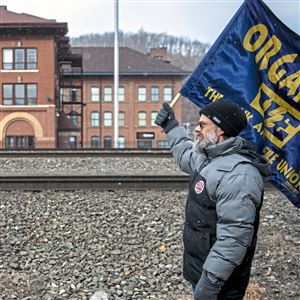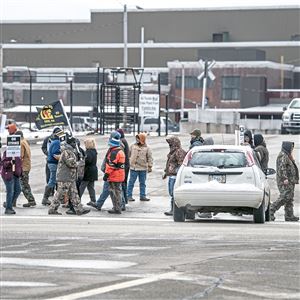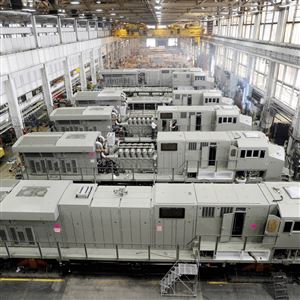Wabtec Corp. and a union representing 1,700 locomotive manufacturing workers in Erie are set to head back to the bargaining table on Wednesday for the first time since union workers surprised the country by calling a labor strike to protest the transportation company’s contract proposals.
The labor strike, which marked its seventh day on Tuesday, was called just hours after Wabtec closed on its $11 billion deal to acquire General Electric’s locomotive-building unit. GE Transportation operated the Erie plant — and negotiated labor contracts with the union — for decades.
Wabtec, based in Wilmerding and planning to move its headquarters to Pittsburgh this year, wants to impose a two-tier wage system that maintains a $35-an-hour wage for current workers but pays lower wages to new hires and workers called back from layoff. The company also wants the ability to require overtime hours when it deems necessary.
The United Electrical, Radio and Machine Workers of America Local 506 refused to work under those terms, calling them major concessions proposed in rushed negotiations. Wabtec has blamed the union for the strike, portraying its proposals as in line with its other plants and necessary to compete with “low cost” plants in China and Mexico.
Over the last week, the company and the union escalated the strike’s public relations battle to win support from residents of Lawrence Park, an Erie County town of a few thousand people founded by GE Transportation in 1910.
“We have 1,700 families in the cold telling the whole world that terms and conditions Wabtec has proposed are unacceptable,” said Scott Slawson, president of the UE Local 506, in an interview Tuesday. “What Wabtec is attempting to do is unwind 82 years of contact negotiations as a very profitable company. It’s not fair to working-class people.
“We’re not going to compete with Chinese wages,” he added. “I don’t care what we do.”
On Tuesday, Wabtec released a statement: “Our intent for the Erie facility is, and has always been, clear: to strengthen its cost structure and position the site for growth, stability and success -– while preserving some of the highest-paying manufacturing jobs in the region for our current employees.”
It added: “Our proven track record of working across sites to implement market-based wage structures will also benefit Erie and position the site for additional work and employee growth — just like it has in locations like Kansas City, Grove City, Cleveland and Las Vegas.”
Both sides are appealing to a national audience that is closely watching the strike as a rare case study of an old-fashioned labor action.
The plant has served as a frequent backdrop from politicians ranging from President Donald J. Trump, Pennsylvania Sen. Bob Casey and Vermont Sen. Bernie Sanders, who offered support to the union that coincides with his 2020 presidential campaign.
The labor strike disrupts work just as Wabtec takes the reins at the Erie plant, a manufacturing and design space that sprawls 3.8 million square feet.
The plant has become a key hub within Wabtec, now a Fortune 500 company with annual revenues expected to more than double to $8.4 billion in 2019. The combined company employs about 27,000 people spread across 50 countries.
Rafael Santana, who served as president and CEO of GE Transportation and was president and CEO of Wabtec’s freight subsidiary, told analysts at the deal’s closing that the company expects a bump in locomotive deliveries in 2019.
In recent months, GE Transportation documented in news releases several orders from rail operators big and small:
• A $1 billion agreement with Ukrainian Railways signed in July 2018 to send dozens of locomotives over 10 years with long-term maintenance services.
• An order announced in September to supply Canadian National Railway with 60 additional locomotives, expanding the Montreal-based carrier’s December 2017 order for 200 units.
• An October order of three locomotives for the Iowa Interstate Railroad.
Representatives of those buyers could not be reached or declined to comment.
During the strike, a Wabtec spokesman said the company has put in place a strike contingency plan. The plan relies on its nonunion managerial employees, and some temporary workers, to step in and pick up some of the union’s work.
Wabtec also has moved some work to a plant in Boise, Idaho, a 300,000-square-foot facility that Wabtec has owned since 1999. The spokesman said Wabtec has a large inventory of parts to meet customer demand.
Through it all, Wabtec’s stock fell about 5 percent since Feb. 25, before the strike was called.
The Erie strike will be an important test of what private-sector unions can accomplish, said Barry Eidlin, assistant professor of sociology at McGill University in Montreal.
Though the frequency of labor strikes “fell off a cliff” in the 1980s, he said, they have resurfaced in the last year — mostly among teachers unions in places like West Virginia, Oklahoma, Denver, Los Angeles and Oakland, Calif.
“The fact this is happening in the manufacturing sector is something really distinctive and a sign the strike wave could be spreading elsewhere,” said Mr. Eidlin, whose 2018 book, “Labor and the Class Idea in the United States and Canada,” explores the decline of unions in America.
“The big debate that’s been going on is whether or not strikes work anymore,” Mr. Eidlin said. “Whether the strike disappearance is the result of a management offensive that has just crushed labor opposition ... or whether the realities of the modern economy are such that it no longer makes sense for unions to use strikes as a tactic.”
Mr. Slawson, the union president, would not promise any progress in Wednesday’s discussions, which are being run by a federal mediator intended to help find common ground and reach a resolution.
“It’s going to be a long day,” he said. “We’ll just have to see what tomorrow brings.”
Daniel Moore: dmoore@post-gazette.com, 412-263-2743 and Twitter @PGdanielmoore
First Published: March 6, 2019, 12:00 p.m.





















